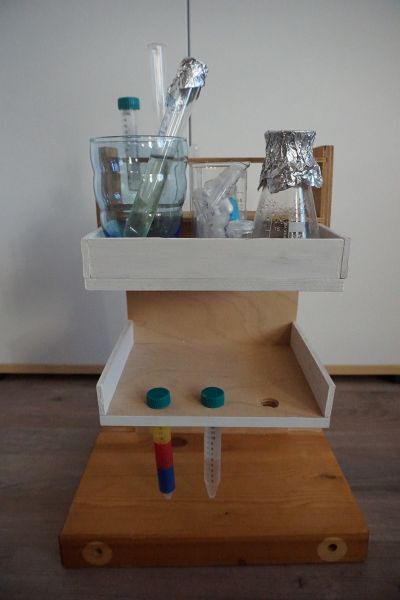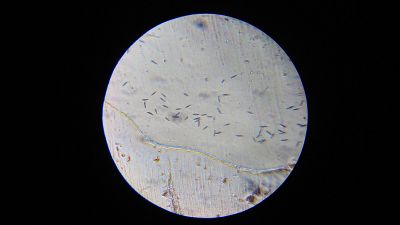Project
My project which I try to implement will be a picture made of Euglenas. If it is possible to move the organisms to places and in shapes I want (and eventuelly create contrasts) this should be realizable. But first I need to find out which options I have and where the borders of this idea are. The following experiments and the documentation of my work shall give an overview. In case of success the outcome will be a kind of installation or at least a piece which lasts for only a few minutes.
Research and Ideas
Interesting projects which mix art and microbiology by Mellissa Fisher:
What fascinates me most about Euglena gracilis is its ability to use photosynthesis or rather the need of this capability to survive.
Photosynthesis means that the organism converts light energy into chemical energy to power its energy balance. Euglena subsist heterotrophic and autotrophic; besides the process of photosynthesis (which is used by plants) it takes nourishment like animals as well. Euglena gracilis is a mixotrophic microorganism.
Besides that, it is able to recognize the stimulus of light (phototaxis). This function helps Euglena to move towards light sources to always assure the facility to use photosynthesis. [1]
During my researches I read the documentation of a project of a former student. She did a couple of experiments which included a tube wrapped with red foil to create a red light source. The result was that the organisms in the tube piled up on the only transparent place without foil because they don't recognize red light.
This made me think of several questions:
- What happens when the whole tube is wrapped with foil and there is only red light? What will the Euglena's concentration be like?
- How do Euglenas react to other colors?
- Is there a color they prefer?
- Can I create contrasts in the concentration by using different colors?
Furthermore, I wondered if it is possible to work creatively with Euglena’s phototaxis. As we can see, it always moves towards the light, so how about taking control over that?
- If I cover a glass receptacle with a dark medium, let’s say black, nontransparent paper, and cut out a shape to let light in, will the organisms accumulate there and fill this shape?
- Is it possible to arrange Euglenas in forms I want them to be?
Preparation
First of all I cooked a medium for Euglena which should promote the reproduction. It contains specific nutrients. Combined with a light position, e.g. at the window or in front of a lamp, they should accrete fast. Those microorganisms cannot be seen with the naked eye but if the population increases, the medium becomes greenish. This is my target goal because this is the state I want to work with.
A small microscope is my tool to observe Euglena. It has no light but a tiny mirror, so I use a flashlight to operate the microscope.
For having an overview of my work and making sure that I can work from home because of the not predictable Covid semester I build a little Euglena Workstation. It includes enough space to place all my tools and do experiments. Also, I can easily move it and position it to places which are reached by the sunlight to optimize Euglena’s growing.
Experiments
Experiment 1
How can I cultivate Euglena faster?
For all the experiments I want to do I need a huge amount of the microorganisms. After observing the medium I already cooked for about three weeks without noticing any change, I wanted to try out something new. I researched some more advices and tips to speed up the reproduction.
Location
- A room temperature of about 21 to 23 degrees Celsius is ideal for growing Euglenas. So this is going to be the new climate of my room.
- Euglena needs light, but no direct solar radiation. I chose a suitable window which fulfills those conditions.
- For making photosynthesis, every visible wavelength in the electromagnetic spectrum of light is utilized. UV-A light has a positive effect on the growing of the chloroplasts while UV-B light can slow down photosynthesis. t is not required in high amounts, so I will waive to use a UV lamp. The light Euglena gets naturally should be enough. [2]
Nutrition
- Euglena is not able to produce vitamin B12 by itself. The absorption occurs by the phagocytosis. This lack can be compensated with a tiny piece of hard cheese or some wheat grain.
- Because CO2 is required for the process of photosynthesis, it is recommended to add some stale mineral water from time to time. I will also use CO2 fertilizer for aquarium plants to see if this works as well. [3]
Initial state
- Before starting the experiment I checked under the microscope whether my Euglenas are still alive. In all three tubes (two with the medium I cooked and one with the „pure“ Euglenas I got for my work) they are moving.
Setup
I prepared six differnt vessels:
- Tube 1 - unchanged Euglena medium; hard cheese
- Tube 2 - unchanged Euglena medium; liquid fertilizer
- Tube 3 - distilled water; hard cheese; liquid fertilizer; CO2 fertilizer once per week
- Tube 4 - distilled water; hard cheese; liquid fertilizer
- Erlenmeyer flask - boilded water; hard cheese; liquid fertilizer; CO2 fertilizer once per week
- Beaker glass - boilded water; hard cheese; liquid fertilizer
I varied the consistence of the mixtures to see which differences I can observe and which of them is the best medium for Euglena.
Expactation
I guess that the nutrients I use this time work better for Euglena. During my researches I saw that various biology pages recommend the use of hard cheese and the addition of CO2. The tubes in which I am going to add CO2 will probably show a better growing of Euglena. Furthermore I think that in the tubes with the medium I have already made, the growing will be a bit faster because those Euglenas already got some nutrients; the pure Euglenas did not.
Implementation
Day 0 - preparing the vessels
Day 2 - recognizing something green settled on the ground of tube 1
Day 3 - adding CO2 to tube 3 and the Erlenmeyer flask; checking the vessels:
- Tube 1 - a lot of microorganisms; approximately the same amount of Euglena and Paramecia; fast movement
- Tube 2 - a lot of microorganisms; more Euglena than Paramecia; fast movement
- Tube 3 - only a few microorganisms; approximately the same amount of Euglena and Paramecia
- Tube 4 - lots of Euglena; few amount of Paramecia
- Erlenmeyer flask - only Paramecia; fast movement
- Beaker glass - only Paramecia; fast movement
Day 5 - The green deposit on the ground of tube one grows. Before taking a sample with the pipet, I shake the tube carefully. After about an hour the deposit settles on the ground again.
checking the vessels:
- Tube 1 - only Euglena; high amount; fast movement
- Tube 2 - a lot of microorganisms; much more Euglena than Paramecia; fast movement
- Tube 3 - only a few microorganisms; approximately the same amount of Euglena and Paramecia
- Tube 4 - only a few microorganisms; more Euglena than Paramecia; slower movement than in the other tubes
- Erlenmeyer flask - only Paramecia; fast movement
- Beaker glass - a lot of Paramecia; few amount of Euglena; fast movement
Experiment 2
How does Euglena react to colors?
Setup: I filled a tube with the Euglena medium (capacity: 15ml) and added about ten drops of Euglenas. To make the light colorful I cut out three stripes of transparent paper and wrapped them around the tube. I chose the fundamental colors yellow, red and blue. As a comparison I also prepared a tube without any paper. To not move the tubes when I put off the paper, I put them in my Euglena Workstation to keep them safe. So I can easily remove the paper without mixing the concentrations accidentally.
Expectation: I guess that the concentration will be very low behind the red and blue paper. As I read during my researches, Euglenas don’t react to red light. Blue is a pretty dark color and I think it won’t attract the organisms much. The yellow paper seems to be the most transparent, so my assumption is that the concentration will be the highest there.
Outcome:
Note: I will start this experiment as soon as the Euglena medium is greenish enough to recognize the visual difference. This experiment is supposed to be repeated with different colors.
Experiment 3
Can I control Euglena's movement?
Setup: I took two pieces of glass (10x15cm) and glued them together on three of four sides. In my first attempt I used sealing glue but it came out that it wasn't watertight. So I tried again with silicone. Between the two glass plates there is a small gap of about 2mm.This gap is filled with the Euglena medium and Euglena. The whole installation is covered with dark, nontranspartent paper on both sides. In the paper I cut some small shapes.
(photo)
Note: I will start this experiment as soon as the Euglena medium is greenish enough to recognize the visual difference.










